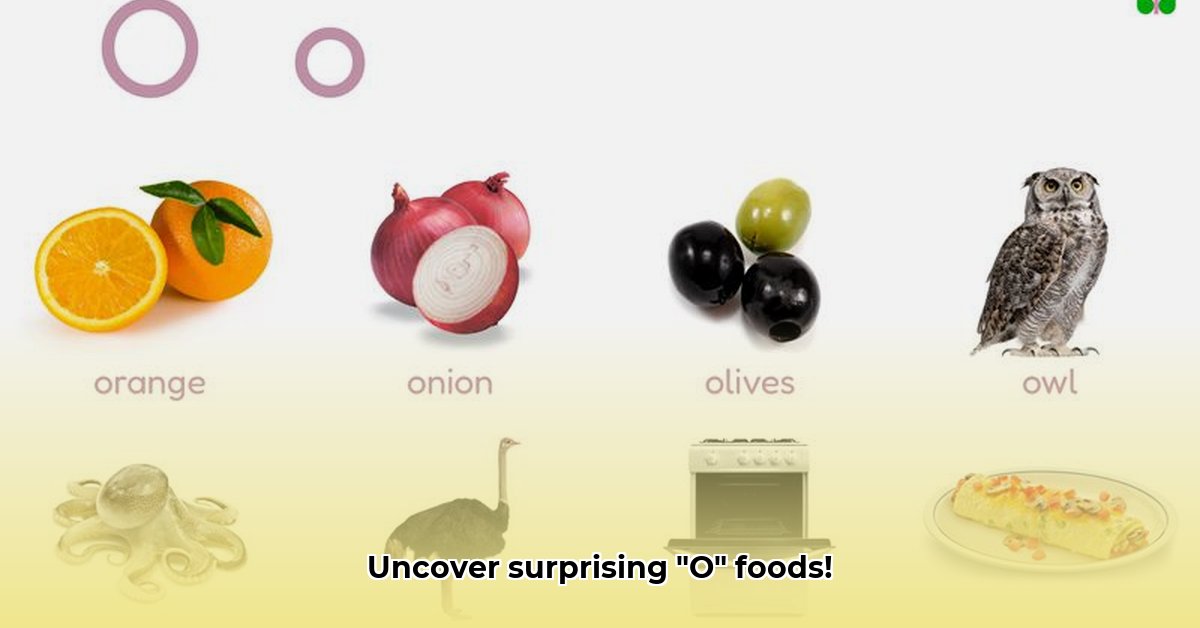Ever notice how many delicious and nutritious foods start with the letter “O”? From breakfast staples to satisfying snacks, “O” foods offer a surprisingly wide range of options. This guide isn’t just a list; it’s your passport to understanding the world of oats, olives, oranges, and more! We’ll explore their nutritional benefits, show you how to use them in your cooking, and even give you tips on making smart choices at the grocery store. For more alphabet-based food exploration, check out this A-foods guide. Get ready to discover some new favorites and level up your meals with the power of “O”!
Foods That Start With O: A Culinary Exploration
Let’s embark on a delicious journey through the world of foods beginning with the letter “O”! This alphabet-inspired exploration reveals a surprising range of flavors, textures, and nutritional benefits, from everyday staples to globally inspired dishes. Get ready to expand your culinary horizons and discover new favorites, including options that cater to diverse dietary needs and preferences.
The Versatile Oat: From Breakfast to Beyond
Oats are far more than just a simple breakfast cereal. These humble grains have become a culinary superstar, appearing in everything from creamy plant-based milks to hearty baked goods. Highlighting their versatility, oats can be incorporated into diverse dishes, bridging traditional and modern cooking styles. Explore the spectrum of oat-based dishes, from savory oatcakes served with cheese to the traditional Scottish oatmeal porridge, showing how oats seamlessly blend into diverse culinary applications. The possibilities truly are endless.
What makes oats so special? The answer lies in their nutritional profile. Packed with soluble fiber, a type of fiber that dissolves in water and forms a gel-like substance in the digestive tract, oats contribute significantly to gut health. Studies have demonstrated that soluble fiber helps regulate blood sugar levels and can even play a role in lowering cholesterol. This makes oats a powerful ally in maintaining overall well-being.
However, it’s crucial to remember that not all oat products are created equal. Many commercially processed options contain added sugars and unhealthy fats, which can diminish their health benefits. To truly maximize the nutritional power of oats, opt for minimally processed varieties like steel-cut oats. Be sure to check ingredient labels carefully to ensure you’re getting the purest form of this grain.
Tips for Choosing the Best Oats:
- Inspect the Ingredient List: A shorter list indicates less processing and fewer additives.
- Prioritize Processing Levels: Steel-cut oats retain more nutrients and fiber than rolled or instant oats.
- Scrutinize Nutrition Facts: Be aware of sugar and fat. Choose options with reduced added sugar for the most nutritional value.
- Consider Organic Options: Opting for organic oats reduces your exposure to pesticides and herbicides.
Beyond the Bowl: Expanding Your “O” Food Repertoire
Oats are indeed a powerhouse, but the world of “O” foods is vast and varied. Let’s explore some other delicious and nutritious options, considering how each can contribute to a balanced and exciting menu.
Oysters: These briny jewels of the sea are enjoyed globally, from raw bars to elegant seafood restaurants. Whether savored raw on the half shell or cooked in sophisticated dishes, oysters offer a unique taste and texture that is simply irresistible. Furthermore, they are a fantastic source of zinc, protein, and omega-3 fatty acids, essential for brain and heart health. When selecting oysters, prioritize sustainability and ensure they come from reputable sources to ensure both freshness and ecological responsibility.
Olives: Small yet mighty, olives add a salty, savory depth to countless dishes. Whether incorporated into a vibrant Mediterranean salad, blended into a flavorful tapenade, or used as a pizza topping, olives deliver a burst of complex flavor. They are also a good source of healthy fats and antioxidants, which help protect cells from damage. Be aware of the sodium content, as it can vary significantly depending on the type and preparation method.
Okra: This distinctive vegetable, with its slightly slimy texture, is a staple in Southern cuisine and beyond. Its unique characteristics lend themselves to a diverse range of cooking applications. Consider frying it for crispy snacks, adding it to soups and stews for natural thickening, or grilling it for a smoky flavor. Okra provides a good source of Vitamin C and fiber. While its texture might not appeal to everyone, many find it a versatile and flavorful ingredient.
Oranges: Bursting with Vitamin C, oranges are a quintessential fruit enjoyed worldwide. From freshly squeezed juice to zesty additions to desserts and savory dishes, oranges bring a vibrant flavor and numerous health benefits. Exploring the variety of orange types, from navel to blood oranges, and learning how to incorporate them into both sweet and savory recipes will further enhance your culinary repertoire.
Nutritional Showdown: Comparing “O” Foods
To make informed dietary choices, let’s take a comprehensive look at the nutritional profiles of some key “O” foods:
| Food | Key Nutritional Highlights | Culinary Uses | Considerations |
|---|---|---|---|
| Rolled Oats | Fiber, iron, magnesium, manganese, antioxidants; can help lower cholesterol and regulate blood sugar levels | Oatmeal, baking (cookies, muffins), granola, smoothies | Can be processed, leading to a loss of some nutrients; may contain added sugars in pre-packaged varieties. |
| Steel-Cut Oats | High in fiber, iron, magnesium, manganese, and antioxidants; minimally processed | Oatmeal, porridge, added to soups or stews for texture | Longer cooking time compared to rolled or instant oats. |
| Oat Milk | Plant-based alternative to dairy milk; often fortified with calcium, vitamin D, and vitamin B12; may contain beta-glucan (a type of soluble fiber that supports heart health) | Beverages, coffee creamer, baking, cooking | Nutritional content varies widely by brand; some brands may contain added sugars, oils, and thickeners; check for glyphosate-free certifications. |
| Oysters | Zinc, protein, omega-3 fatty acids, vitamin B12, selenium; low in calories and fat | Raw on the half-shell, grilled, fried, steamed, added to stews and chowders | Pricey; sustainability concerns (choose from reputable sources); potential allergens; should be consumed fresh and properly prepared to avoid foodborne illnesses. |
| Olives | Healthy monounsaturated fats, antioxidants (including oleic acid and hydroxytyrosol), vitamin E; anti-inflammatory properties | Salads, tapenades, pizzas, pasta dishes, olive oil production | High sodium content in some varieties (especially brined olives); calorie-dense due to high fat content. |
| Okra | Vitamin C, fiber, vitamin K, folate, antioxidants; may help regulate blood sugar levels | Fried, stewed, grilled, pickled, added to gumbos and soups | Mucilaginous texture may be off-putting to some; some people may experience digestive discomfort. |
| Oranges | Vitamin C, potassium, folate, antioxidants (including flavonoids); supports immune function and skin health | Juice, fresh fruit, salads, desserts, marmalades, flavoring for savory dishes | High in natural sugars; some people may experience acid reflux or heartburn due to the acidity. |
Making Smart Choices: Empowering Your Dietary Decisions
The “O” food group presents a remarkable spectrum of flavors and nutritional benefits. By understanding the unique characteristics of each food, you can make well-informed choices that align with your health goals and preferences. Remember, even the most nutritious foods should be enjoyed in moderation as part of a balanced diet. What new “O” food will you explore next to enrich your meals and overall well-being?
How to Select the Most Nutritious Oat Milk
Oat milk’s surge in popularity has led to a wide array of brands, making it challenging to choose the healthiest option. Let’s break down how to navigate the oat milk aisle, focusing on ingredients, nutritional facts, and other factors to help you make informed decisions.
Deciphering Oat Milk Ingredients
A critical step in learning how to select the most nutritious oat milk is understanding ingredient lists. Many brands incorporate sugars, oils, and stabilizers to enhance texture and shelf life. While these additions might improve the sensory experience, they often detract from the nutritional value.
- Added Sugars: Opt for oat milk with minimal or no added sugars. Note that even “naturally occurring” sugars from the enzymatic breakdown of oats can contribute to overall sugar content. Check the label carefully.
- Added Oils: Ingredients like sunflower and canola oils are frequently used to enhance creaminess. While not inherently harmful, excessive amounts can add unnecessary calories and fat. Prioritize brands that avoid these oils or use them sparingly.
- Gums and Emulsifiers: These ingredients, such as gellan gum and lecithin, are designed to improve texture but don’t contribute to nutritional value. Choosing minimally processed brands with shorter ingredient lists is generally a healthier approach.
Key Nutrients to Prioritize
Beyond avoiding unwanted additions, it’s essential to focus on the nutrients you want in your oat milk.
- Fortification: Many brands fortify their oat milk with essential vitamins and minerals, such as calcium, vitamin D, and vitamin B12. These additions can significantly enhance the nutritional profile,
- Smart Meal Prep Recipes Gluten Free for Dietary Needs - November 29, 2025
- Gluten Free Meal Prep Ideas for Delicious, Hassle-Free Eating - November 28, 2025
- Gluten Free Meal Prep for Stress-Free and Healthy Eating - November 27, 2025










